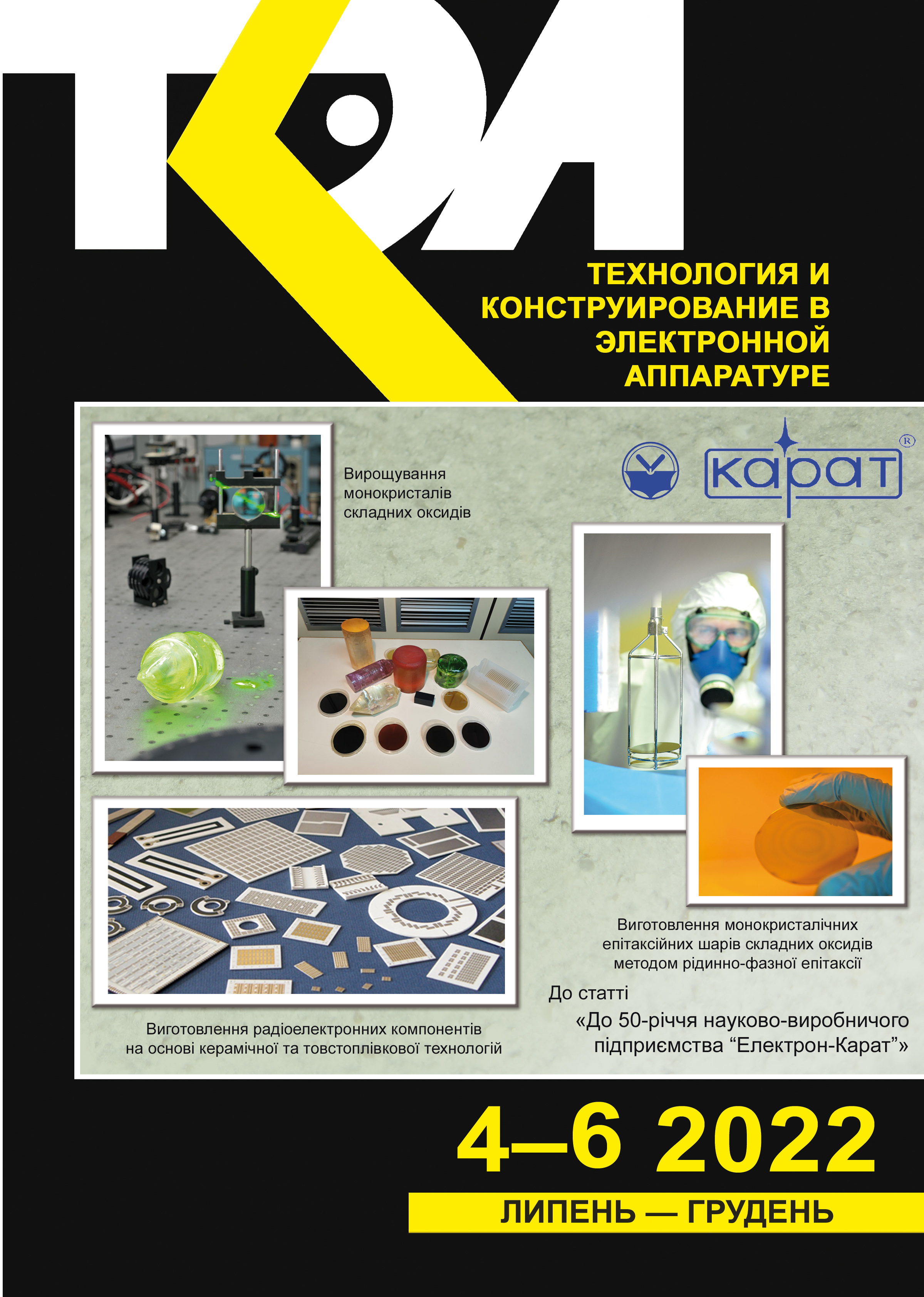Estimating purity of Cd, Zn, Pb by non-contact measurement of specific electrical resistance at liquid nitrogen temperature
Abstract
High-purity fusible metals Cd, Zn, Pb and archaeological archPb are used as component elements in semiconductor and low-background scintillation detectors based on CdTe, CdZnTe, CdWO4 PbWO4, ZnWO4 required for registering ionizing radiation and searching for particles of dark matter, rare alpha and beta decays. The detection efficiency and the sensitivity of detectors significantly depend on the purity of the constituent elements of detector materials. The dependence of the resistivity of fusible metals Cd, Zn, Pb on the degree of their purity was studied using the non-destructive technique of registering the decaying vortex currents induced in cylindrical samples after dropping the external magnetic field. The aim of the work was to determine the possibility of evaluating the purity of fusible metals using a simple methodology for measuring the characteristic times of decay of vortex currents at 77 K without the use of liquid helium. The computer analysis of the recorded signals presented in the form of decaying curves allowed finding the areas where the signal can be represented as an exponent with a characteristic decay time τ and determining a formula that related τ, specific resistance РџРѓ, and the diameter of cylindrical samples. A comparison of the РџРѓ values of both the initial samples of cadmium, zinc, lead, and archaeological lead, and those samples after various purification procedures, allowed establishing the dependence of the resistivity on the purity of the studied materials at the temperature of liquid nitrogen ρ77. The greater the difference in the purity of the fusible metal, the more their values ρ77 were different. Thus, the authors substantiated the possibility of a qualitative assessment of the purity of metals using contactless measurement and comparison of ρ77 for samples obtained after growing and various deep purification procedures.
References
Abbaspour S., Mahmoudian B., Islamian J. P. Cadmium telluride semiconductor detector for improved spatial and energy resolution radioisotopic imaging. World J. Nucl. Med. 2017, vol. 16, iss. 2, pp. 101-107. https://doi.org/10.4103/1450-1147.203079
Johns P. M., Nino J. C. Room temperature semiconductor detectors for nuclear security. J. Appl. Phys, 2019, vol. 126, iss. 4, pp. 040902-1 - 040902-21. https://doi.org/10.1063/1.5091805
Ridzonova K., Belas E., Grill R., Pekarek J., Praus P. Space charge limited photocurrents and transient currents in CdZnTe radiation detectors. Phys. Rev. Applied, 2020, vol. 13, iss. 6, 064054. https://doi.org/10.1103/PhysRevApplied.13.064054
Christos M., Koukou V., Martini N. et al. Luminescence efficiency of cadmium tungstate (CdWO4) single crystal for medical imaging applications. Crystals, 2020, vol. 10 (6), pp. 429-1-426-16. https://doi.org/10.3390/cryst10060429
Ziluei H., Azimirad R., Larijani M., Ziaie F. Preparation and optimization of CdWO4-polymer nano-composite film as an alpha particle counter. Nucl. Instrum. Methods Phys. Res. A, 2017, vol. 852, pp. 85-90. https://doi.org/10.1016/j.nima.2017.01.015
Ying Zhang, Xianchun Zhu, Yao Zhao et al. CdWO4:Eu3+ nanostructures for luminescent applications. ACS Appl. Nano Mater., 2019, vol. 2, iss. 11, pp. 7095-7102. https://doi.org/10.1021/acsanm.9b01625
Kim M.J., Park H., Kim H.J. Characterization of PbWO4 crystals for high-energy physics experiments. Journal of the Korean Physical Society, 2016, vol. 69, iss. 6, p.1130-1134. https://doi.org/10.3938/jkps.69.1130
Nedilko S., Chukova O. Luminescent spectroscopy of the Yb3+ ions in the PbWO4 crystal. Acta Phys. Polon., 2018, vol. 133, no. 4, pp. 918-922. https://doi.org/10.12693/APhysPolA.133.918
Belli P., Bernabei R., Borovlev Yu. A. et al. New development of radiopure ZnWO4 crystal scintillators. Nucl. Instrum. Methods Phys. Res. A, 2019, vol. 935, iss. 11, pp. 89-94. https://doi.org/10.1016/j.nima.2019.05.014
Heon Yong Jeong, Ju Hyuk Lee, Sang Yoon Lee et al. A transparent nano-polycrystalline ZnWO4 thin-film scintillator for high-resolution x-ray imaging. ACS Omega, 2021, vol. 6, iss. 48, pp. 33224-33230. https://doi.org/10.1021/acsomega.1c05962
Belli P., Bernabei R., Borovlev Yu.A. et al. Optical, luminescence, and scintillation properties of advanced ZnWO4 crystal scintillators. Nucl. Instrum. Methods Phys. Res. A, 2022, vol. 1029, 166400. https://doi.org/10.1016/j.nima.2022.166400
Barabash A.S. Double beta decay experiments: current status and prospects. Physics Procedia, 2014, vol. 57, no. 5, pp. 416-422. https://doi.org/10.1016/j.phpro.2015.09.215
Danevich F.A., Georgadze A.Sh., Kobychev V.V. et al. Application of PbWO4 crystal scintillators in experiment to search for 2ОІ decay of 116Cd. Nucl. Instrum. Methods Phys. Res. A. 2006, vol. 556, iss. 1, pp. 259-265. https://doi.org/10.1016/j.nima.2005.09.049
Pattavina L., Iachellini N.F., Tamborra I. Neutrino observatory based on archaeological lead. Phys. Rev. D, 2020, vol. 102, iss. 6, 063001. https://doi.org/10.1103/PhysRevD.102.063001
Guoqiang Li, Xiaolu Zhang, Hui Hua, Wanqi Jie. Upgrading of CdZnTe by annealing with pure Cd and Zn metals. Semiconductor Science and Technology, 2006, vol. 21, no. 3, pp. 392-396. https://doi.org/10.1088/0268-1242/21/3/032
Zaioura A., Ayoubb M., Hamiec A. et al. Preparation of high purity CdTe for nuclear detector: electrical and nuclear characterization. Physics Procedia, 2014, vol. 55, pp. 476-484 https://doi.org/10.1016/j.phpro.2014.07.069
Shcherban A. P., Kovtun G. P., Gorbenko Y. V. et al. Production of high purity granular metals: cadmium, zinc, lead. Tekhnologiya i Konstruirovanie v Elektronnoi Apparature, 2017, no. 1-2, ppp. 55-60. https://doi.org/10.15222/TKEA2017.1-2.55 [Rus]
Shcherban A. P., Kovtun G. P., Solopikhin D. A. A device for refining metals by vacuum distillation. Pat. 94547 UA, 2011. [Ukr]
Boiko R.S., Virich V.D., Danevich F.A. et al. Ultrapurification of archaeological lead. Inorganic Materials, 2011, vol. 47, no. 6, ppp. 645-648. https://doi.org/10.1134/S0020168511060069
Babichev A.P., Babushkina N.A., Bratkovsky A.M. et al. Fizicheskiye velichiny. Spravochnik [Physical quantities. Handbook]. Moskow, Energoatomizdat, 1991, 1232 pp. [Rus]
Copyright (c) 2022 Kondrik A. I., Kovtun G. P., Shcherban O. P., Solopikhin D. O.

This work is licensed under a Creative Commons Attribution 4.0 International License.

